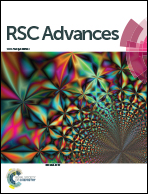Synthesis and photochemical properties of BODIPY-functionalized silica nanoparticles for imaging Cu2+ in living cells†
Abstract
A highly selective copper(II) sensor based on BODIPY-functionalized silica nanoparticles, BODIPY–DPA@SN, is designed and synthesized. Its absorption and fluorescence maxima in dry organic solvents are red-shifted by ∼75 and ∼50 nm compared with those of the BODIPY fluorophore and are blue-shifted by ∼55 and ∼15 nm, respectively, in aqueous–organic (1 : 1, v/v) media with fluorescence enhancement. The fluorescence intensity almost increases linearly as a function of water concentration (below 5%, v/v). BODIPY–DPA@SN exhibits high specificity for Cu2+ over other transition metal ions in aqueous–organic media, resulting in notable fluorescence quenching and a visible pink-to-yellow color change. Confocal microscopy experiments successfully proved that BODIPY–DPA@SN can be a biosensor for copper in living cells.


 Please wait while we load your content...
Please wait while we load your content...